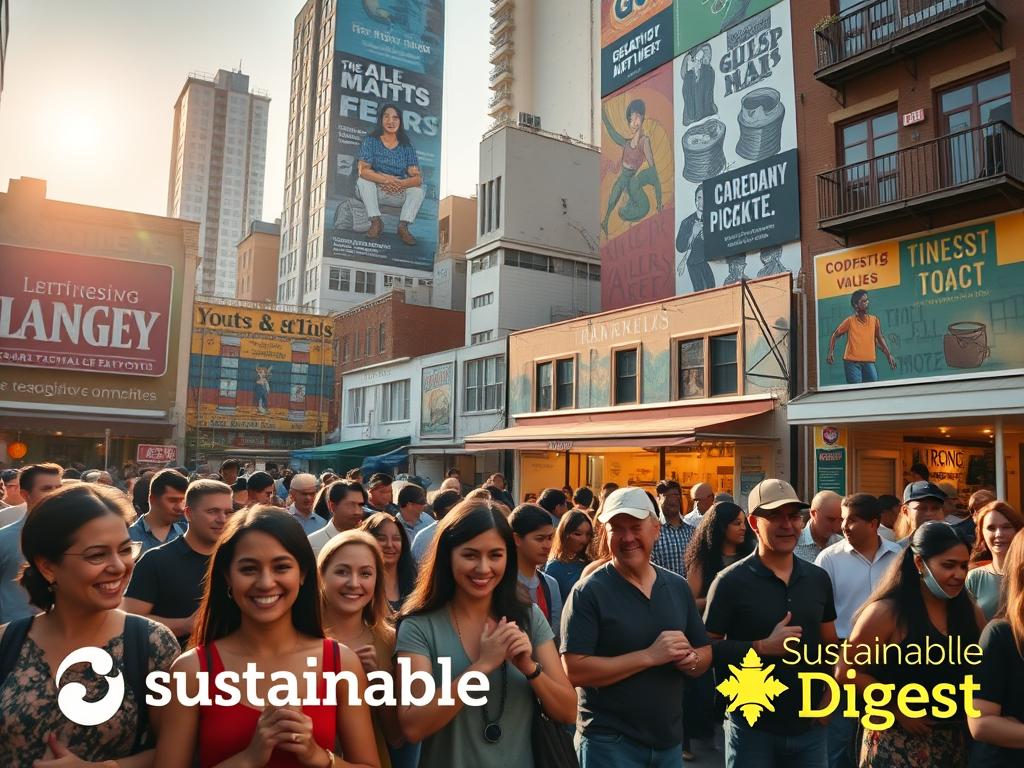
June 5th is a big day for the world. It’s when we celebrate World Environment Day and other important environmental events. It’s a time to think about how we affect the Earth and why we need to live sustainably.
The Sustainable Development Goals (SDGs) from the United Nations are key. They help us work towards a greener future. Earth Overshoot Day reminds us of the urgent need for living sustainably. It’s the day when we use more resources than the Earth can replace in a year.

The Significance of Environmental Observances in Global Sustainability
The world faces many environmental challenges. Observances focused on sustainability are now crucial. They remind us of the need to live sustainably and lessen our impact on the planet.
How Environmental Days Drive Awareness and Action
Environmental days are more than just gestures. They spark change. By setting aside days for environmental causes, we bring attention to issues like climate change and pollution.
Measuring Impact of Environmental Campaigns
We can see how effective environmental campaigns are in different ways. For example, Earth Overshoot Day helps show how we use too many resources. It encourages people and governments to act on climate action.
| Environmental Observance | Primary Focus | Impact |
|---|---|---|
| Earth Overshoot Day | Ecological footprint | Raises awareness about resource depletion |
| World Environment Day | Environmental conservation | Promotes global action for environmental protection |
Connecting Environmental Observances to the United Nations Sustainable Development Goals
The United Nations’ Sustainable Development Goals (SDGs) aim for a sustainable future. Environmental observances tie into many of these goals, especially those about climate action and environmental conservation.
The 17 SDGs and Their Environmental Components
Many SDGs focus on the environment. For instance, SDG 13 is about climate action. SDG 14 and SDG 15 deal with the ocean and land. By joining environmental observances, we help meet these goals.
World Environment Day: A Global Platform for Environmental Action
World Environment Day has grown into a big movement for protecting our planet. It’s a place where governments, businesses, and people join hands to tackle big environmental problems.
History and Evolution of World Environment Day
World Environment Day started in 1972 with the United Nations Environment Programme (UNEP). The first event was in 1973. Now, it’s an annual event.
UNEP’s Role in Establishing and Promoting WED
The UNEP is key in promoting World Environment Day. It picks a theme each year and organizes global events. “The future depends on what we do today,” is a message that matches the UNEP’s goal to encourage action on the environment.

World Environment Day Themes Through the Years
World Environment Day has covered many themes over the years. From fighting climate change to promoting green living. For example, in 2022, the focus was on “Only One Earth,” pushing for sustainable living.
How Americans Participate in World Environment Day
In the US, people celebrate World Environment Day in many ways. They organize clean-up events, educational programs, and efforts to cut down carbon emissions.
Notable US-Based WED Initiatives
In the US, there are standout initiatives like the “Trash Free Seas” program by the Ocean Conservancy and the “Climate For Change” campaign by the Environmental Defense Fund. These show how Americans are getting involved with World Environment Day.
As
“We do not inherit the earth from our ancestors, we borrow it from our children.”
This Native American saying captures the essence of World Environment Day. It urges us to take care of the planet for future generations.
Understanding Earth Overshoot Day and Ecological Footprints
Earth Overshoot Day is when we use more resources than the Earth can replace. It’s found by dividing the Earth’s biocapacity by our ecological footprint. Then, we multiply by 365, the days in a year.
What Is Earth Overshoot Day and How Is It Calculated?
To find Earth Overshoot Day, we look at the Earth’s biocapacity and our ecological footprint. Ecological footprint is how much land we need for food, fibers, and to absorb waste, like carbon emissions.
The Science Behind Ecological Footprint Measurement
Measuring ecological footprint involves many factors. These include what we consume and how we use resources. Advanced methodologies help turn these into a clear metric.
Historical Trends in Earth Overshoot Day
| Year | Earth Overshoot Day |
|---|---|
| 1970 | December 29 |
| 2000 | November 1 |
| 2020 | August 4 |
The United States’ Ecological Footprint and Overshoot Impact
The U.S. has a big ecological footprint due to high consumption and carbon emissions. Knowing this helps us make better sustainability plans.
State-by-State Sustainability Variations
Ecological footprints vary by state in the U.S. This depends on population, energy use, and land use. States with more people and industry have bigger footprints.
The International Day for the Fight Against Illegal, Unreported and Unregulated Fishing
Fighting against Illegal, Unreported and Unregulated (IUU) fishing is key to keeping our oceans healthy. IUU fishing harms fish populations, damages marine habitats, and puts the livelihoods of fishing communities at risk.
The Environmental Impact of Illegal Fishing
IUU fishing causes big environmental problems. It depletes fish stocks, destroys habitats, and harms endangered species. It also hinders conservation efforts and can collapse fisheries, harming biodiversity and ecosystem balance.

Global Initiatives to Combat Illegal Fishing
There are global efforts to fight IUU fishing. These include setting up monitoring systems and making international agreements. The goal is to promote sustainable fishing and protect marine resources.
US Policies and International Cooperation
The United States has its own plans to tackle IUU fishing, like the Illegal, Unreported, and Unregulated Fishing Agreement Act. Working together with other countries and organizations is also key. This helps share knowledge and coordinate actions against IUU fishing.
Connection to SDG14: Life Below Water
The battle against IUU fishing is tied to SDG14: Life Below Water. This goal aims to protect and use the oceans, seas, and marine resources sustainably. Fighting IUU fishing is vital for achieving this and keeping marine ecosystems healthy for the long term.
Cultural and Religious Observances on June5th
June 5th is a day filled with cultural and religious celebrations worldwide. It’s known for environmental events, but it’s also important in many religious calendars.

Orthodox Ascension Day: Traditions and Practices
Orthodox Ascension Day is a big deal for Orthodox Christians. It honors the day Jesus Christ went to heaven. People usually go to church services and join in processions.
Environmental Themes in Orthodox Christian Teachings
Orthodox teachings stress the need to care for the earth. They talk about stewardship of the earth and its resources. These ideas match with global efforts to protect the environment.

Day of Arafah: Significance in Islamic Tradition
The Day of Arafah is a key day in Islam, right after the Hajj pilgrimage starts. It’s a time for reflection and prayer. Many Muslims fast on this day, hoping for forgiveness.
Islamic Perspectives on Environmental Stewardship
Islam also teaches about taking care of the environment. The Quran says it’s crucial to conserve natural resources and protect the earth. This is seen as a divine command.

National Celebrations on June5th Around the World
National celebrations on June 5th show a rich mix of cultural traditions and historical events. These events are special to their countries but unite them in promoting national identity and unity.
Khordad National Uprising in Iran: Historical Context
The Khordad National Uprising in Iran is on June 5th. It remembers a key moment in the country’s fight for democracy and freedom. This day reminds us of Iran’s ongoing push for political reform and social justice.
Constitution Day in Denmark: Celebrating Democracy

Denmark celebrates Constitution Day on June 5th. It marks the 1849 signing of the Danish constitution. This day honors Danish democracy and the principles of constitutional monarchy. It shows Denmark’s dedication to democratic values and the rule of law.
President’s Day in Equatorial Guinea
Equatorial Guinea honors its head of state on President’s Day, June 5th. This day is a chance to think about the country’s political leadership and its role in development. It emphasizes the role of effective governance in achieving national stability and prosperity.
How National Celebrations Can Promote Sustainability
National celebrations can help promote sustainability by bringing attention to environmental and social issues. By adding sustainability themes to these celebrations, countries can encourage a culture of environmental care and social responsibility.
| Country | Celebration | Sustainability Theme |
|---|---|---|
| Iran | Khordad National Uprising | Democracy and Freedom |
| Denmark | Constitution Day | Democratic Values |
| Equatorial Guinea | President’s Day | National Leadership |

Earth Overshoot Day, World Environment Day & June5th Observances for the UNSDGs
Observing Earth Overshoot Day and World Environment Day on June 5th is more than a coincidence. It’s a call to action for the United Nations Sustainable Development Goals (UNSDDGs). These environmental observances highlight the critical need for sustainable practices. They show how ecological health and human well-being are connected.
How These Observances Support the 17 Sustainable Development Goals
The UNSDGs are a universal call to action. They aim to end poverty, protect the planet, and improve lives everywhere. Earth Overshoot Day and World Environment Day directly support several of these goals, especially those related to environmental sustainability.
SDGs 13, 14, and 15: Climate Action, Life Below Water, Life on Land
Climate Action (SDG 13) is crucial as it addresses the need to reduce greenhouse gas emissions. It aims to mitigate the impacts of climate change. Life Below Water (SDG 14) and Life on Land (SDG 15) are also directly supported through efforts to conserve marine and terrestrial ecosystems.
These goals are interconnected. For instance, reducing carbon emissions (SDG 13) helps protect marine ecosystems (SDG 14) and preserve biodiversity on land (SDG 15). Observances like Earth Overshoot Day and World Environment Day raise awareness about the urgency of these issues.
Case Studies of Successful SDG Implementation Through Environmental Awareness
Several organizations and initiatives have successfully implemented SDGs through environmental awareness campaigns. For example, initiatives focusing on reforestation and reducing plastic waste have made significant impacts.
American Organizations Leading the Way
American organizations are at the forefront of SDG implementation. For instance, The Nature Conservancy works on conservation efforts globally, including in the United States. They support SDGs 13, 14, and 15. The Environmental Protection Agency (EPA) also plays a crucial role in promoting environmental sustainability and supporting the achievement of the SDGs.
These organizations demonstrate how focused environmental initiatives can drive progress toward the UNSDGs. They serve as models for global action.
Philippine Eagle Week: Spotlight on Biodiversity Conservation
Philippine Eagle Week highlights the need to save the Philippine Eagle, a unique bird found only in the Philippines. It shows how vital biodiversity conservation is. We must keep working to protect endangered animals.
The Philippine Eagle: A Symbol of Conservation Challenges
The Philippine Eagle is one of the biggest and strongest eagles worldwide. It’s a symbol of the Philippines’ rich wildlife. But, it’s in danger because of lost habitats and hunting. It’s crucial to save it.

Conservation Efforts and Success Stories
Many programs aim to save the Philippine Eagle and its home. These include protecting habitats, doing research, and working with local communities. Help from other countries is also key.
International Cooperation in Species Protection
Working together is vital to protect birds like the Philippine Eagle. Governments, NGOs, and local groups have made big strides in conservation.
| Conservation Effort | Description | Impact |
|---|---|---|
| Habitat Preservation | Protection of forests and natural habitats | Reduced habitat loss |
| Research Initiatives | Studies on species behavior and habitat needs | Informed conservation strategies |
| Community Engagement | Education and involvement of local communities | Increased support for conservation |
Lessons for Global Biodiversity Protection
Learning from the Philippine Eagle’s conservation is important for protecting wildlife worldwide. It shows the value of working together, involving communities, and keeping up conservation efforts.
Applications for US Conservation Programs
The lessons from saving the Philippine Eagle can help US conservation efforts. Working together and engaging communities are essential.
Taking Action: How Individuals and Communities Can Participate
As we celebrate environmental days, we focus on what we can do. We can all help make the world a better place. This includes reducing our impact on the planet and working together in our communities.
Personal Ecological Footprint Reduction Strategies
Reducing our ecological footprint is key to a sustainable future. Small changes in our daily lives can have a big impact. Eating less meat, using less energy, and throwing away less waste are good ways to start.
Practical Steps for American Households
American homes can make a difference too. Using less energy, saving water, and avoiding single-use plastics are good steps. These actions help our planet and keep us healthy.

Community-Based Environmental Initiatives
Community efforts are crucial for saving our environment. Events like clean-ups, planting trees, and teaching about nature are great ways to help. They show how we can all make a difference together.
Success Stories from US Communities
In the US, many communities have made big changes for the better. They’ve started gardens in cities and worked on renewable energy projects. These stories show the power of working together.
Digital Activism and Awareness Campaigns
In today’s world, using the internet to help the environment is very powerful. Social media lets us share important messages and get people involved in saving our planet.
Effective Social Media Strategies for Environmental Advocacy
Good social media plans include making interesting content and using hashtags. Working with influencers can also help spread the word. These strategies help us reach more people and encourage them to take action.

Conclusion: The Future of Environmental Observances in Advancing Sustainability
Environmental observances throughout the year are key to advancing sustainability. Events like Earth Overshoot Day and World Environment Day remind us of our planet’s importance. They urge us to protect our planet and its resources.
It’s vital to keep supporting and joining these observances. This helps build a culture of sustainability. It encourages everyone to work towards a greener future.
The success of these observances depends on our collective efforts. We need individuals, communities, and governments to work together. This way, we can ensure a sustainable future for everyone.

Key Takeaways
- June 5th is a significant day for environmental awareness.
- World Environment Day promotes global sustainability.
- The United Nations SDGs guide efforts towards a sustainable future.
- Earth Overshoot Day highlights the need for sustainable living.
- Sustainable practices are crucial for the planet’s future.
